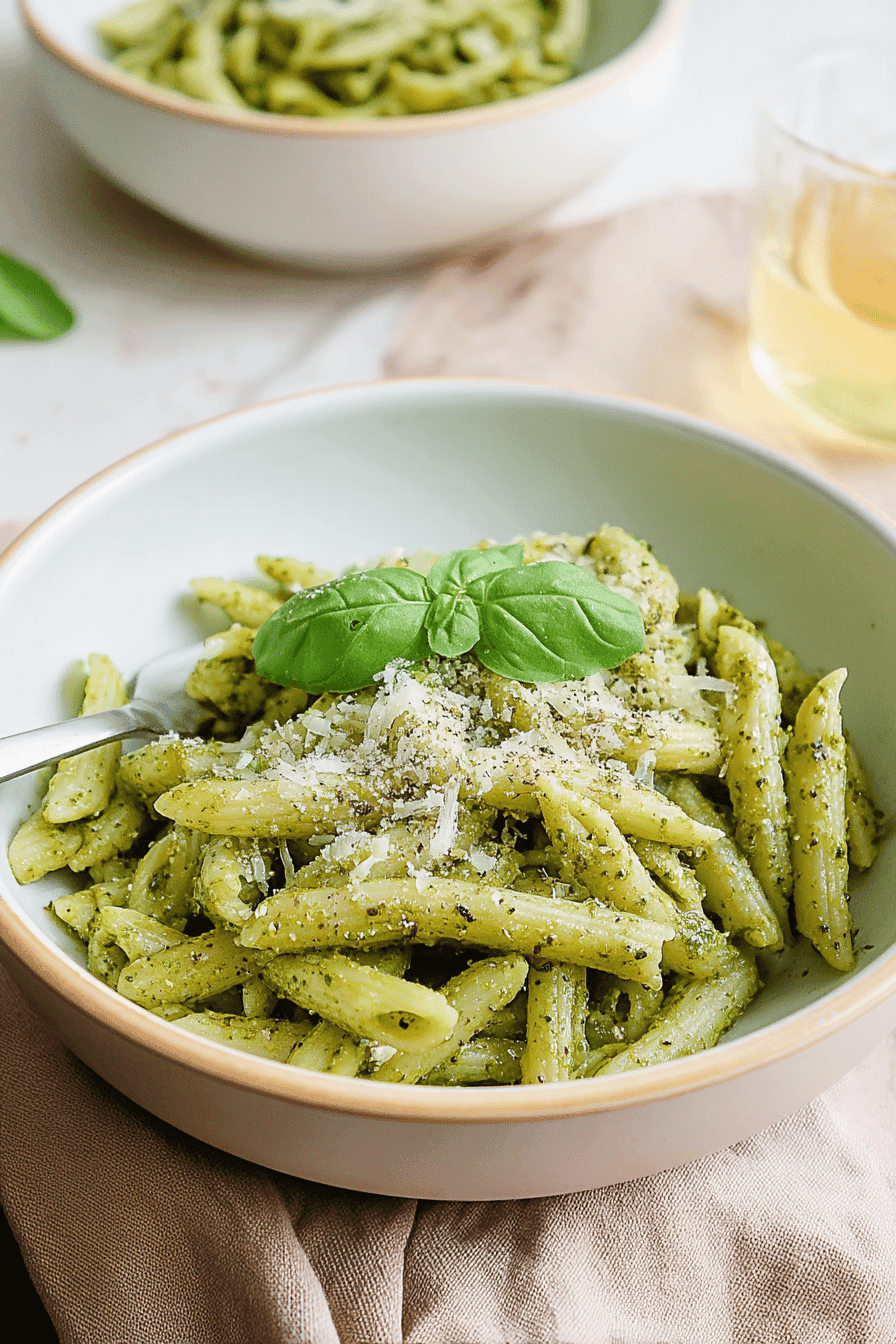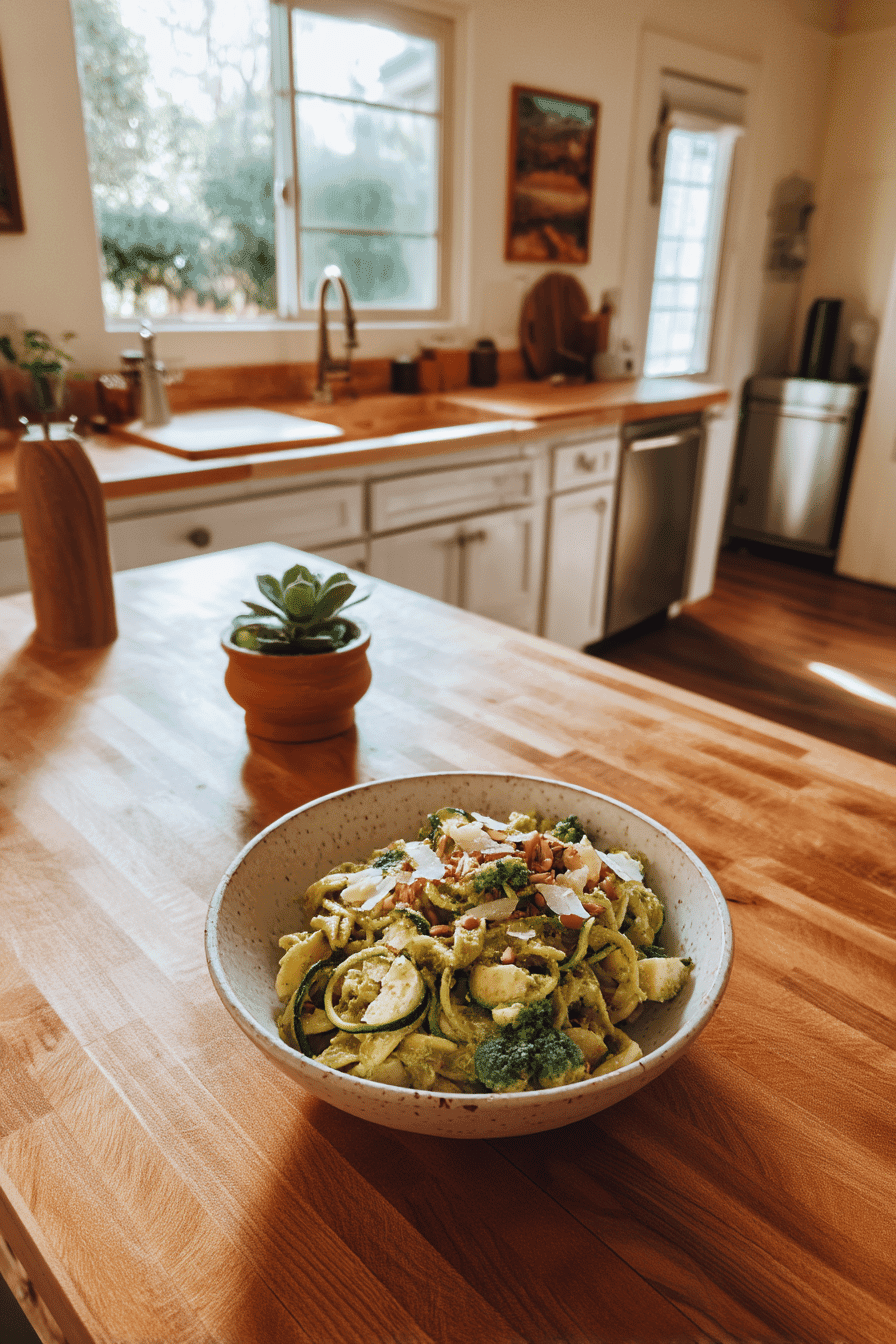Benefits and Advantages of Zucchini Pesto Pasta
Zucchini pesto pasta offers an exceptional combination of ease and nutrition, making it a standout choice for a quick and healthy meal. The preparation is straightforward, typically requiring just a few simple steps and minimal cooking time, which is perfect for busy lifestyles. Health-wise, zucchini is low in calories and rich in vitamins A and C, antioxidants, and fiber, contributing to improved digestion and immune health. Learn more about the benefits of zucchini to understand why it is such a nutritious addition to your diet.
The pesto, often made from fresh basil, nuts, and olive oil, adds heart-healthy fats and a burst of flavor without excess calories or processed ingredients. This zucchini-based pasta alternative is also versatile, accommodating various dietary preferences, including vegan and gluten-free options when paired with suitable pasta types. It stands out because it combines fresh, wholesome ingredients with a delicious, vibrant taste, suitable for everyday meals or special occasions.
Its ability to be customized enhances its appeal, allowing home cooks to adapt the recipe with different nuts, herbs, or nutritional additives such as spinach or kale. Thus, zucchini pesto pasta is both a nutritious and convenient meal option that provides a delightful alternative to traditional pasta dishes.
“Zucchini pesto pasta is a quick, healthy, and versatile dish that suits busy schedules without sacrificing flavor or nutrition.”
Jump To
- 1. Benefits and Advantages of Zucchini Pesto Pasta
- 2. Essential Ingredients for Zucchini Pesto Pasta
- 3. Dietary Substitutions to Customize Your Zucchini Pesto Pasta
- 4. How to Prepare the Perfect Zucchini Pesto Pasta: Step-by-Step Guide
- 5. Advanced Tips and Variations
- 6. How to Store Zucchini Pesto Pasta: Best Practices
- 7. Nutritional Value of Zucchini Pesto Pasta
- 8. FAQs: Frequently Asked Questions About Zucchini Pesto Pasta
- 9. Quick and Creamy Zucchini Pesto Pasta Recipe in 30 Minutes
Essential Ingredients for Zucchini Pesto Pasta
Key ingredients form the backbone of any great dish, and zucchini pesto pasta is no exception. Below is a structured list of the essential components needed for this flavorful recipe:
- Dry Pasta: 8 ounces (about 225 grams) penne, casarecce, linguine, or a similar shape
- Salt: About 2 teaspoons, for the pasta cooking water
- Zucchini: 3 medium zucchinis (approximately 1 1/2 pounds or 680 grams), trimmed and sliced into half-moons or coins, or coarsely grated for a caramelized texture
- Garlic: 2 tablespoons minced or 2 thinly sliced cloves
- Extra-Virgin Olive Oil: 2 to 5 tablespoons, divided (adjust to taste)
- Salt and Black Pepper: To season
- Basil Pesto: 1 cup, store-bought or homemade (see how to make basil pesto sauce)
- Reserved Pasta Cooking Water: 1/2 to 1 cup, to adjust sauce consistency
- Parmesan Cheese: 1/2 cup coarsely grated, optional, plus additional for serving
- Optional Additions:
- 2 tablespoons unsalted butter for added richness
- About 1/4 cup toasted walnuts or pistachios for crunch
- Zest and juice from 1 lemon for brightness
- Fresh basil leaves for garnish
- About 1/4 cup burrata or ricotta cheese for a creamy finish
| Ingredient | Quantity | Purpose |
|---|---|---|
| Dry Pasta | 8 ounces (225 grams) | Base carbohydrate, provides texture and structure |
| Zucchini | 3 medium (1 1/2 pounds) | Low-calorie pasta alternative and moisture |
| Basil Pesto | 1 cup | Flavorful sauce with healthy fats and herbs |
| Garlic | 2 tablespoons minced or sliced | Aromatic and antioxidant boost |
| Olive Oil | 2 to 5 tablespoons | Source of heart-healthy fats |
| Parmesan Cheese (Optional) | 1/2 cup grated plus more for serving | Adds savory depth and umami |
Each ingredient has been carefully selected to maximize flavor, health benefits, and versatility. For those with dietary restrictions, gluten-free pasta or dairy-free cheese options can be used without sacrificing the dish’s quality. This approach ensures that zucchini pesto pasta remains a crowd-pleaser tailored to a range of eating habits.
For an alternative protein-rich option to complement this pasta dish, check out the Garlic Parmesan Chicken recipe for a quick and tasty addition to your meal plan.
Dietary Substitutions to Customize Your Zucchini Pesto Pasta
Zucchini pesto pasta is naturally versatile and can be easily customized to satisfy various dietary preferences and restrictions. Here are some thoughtful substitutions to tailor this dish while keeping its vibrant flavor and texture intact.
Vegan and Dairy-Free Options
- Replace Parmesan cheese with nutritional yeast or vegan cheese alternatives to maintain that umami, cheesy flavor without dairy.
- Ensure the pesto recipe uses only plant-based nuts and oils, such as extra-virgin olive oil and walnuts or pine nuts.
Gluten-Free Adaptations
- Use gluten-free pasta options like rice, chickpea, or corn-based pasta.
- Alternatively, prepare the dish with spiralized zucchini noodles alone, which are naturally gluten-free and low-carb.
Calorie and Fat Reduction
- Reduce or omit the olive oil in the pesto and instead use a light misting of olive oil spray to lower fat content.
- Increase zucchini quantity as a pasta substitute to keep the dish light while filling.
Nut Allergies
- Replace traditional nuts like pine nuts or walnuts with seeds such as sunflower seeds or pumpkin seeds, which offer great crunch and nutrition without allergens.
Boosting Protein Content
- Add cooked chickpeas or white beans tossed into the pasta.
- Incorporate a scoop of plant-based protein powder blended into the pesto sauce.
Histamine Intolerance-Friendly Alternatives
- Swap fresh basil with milder herbs such as cilantro.
- Replace lemon juice with a splash of apple cider vinegar to reduce histamine triggers.
These substitutions maintain the signature taste and texture of zucchini pesto pasta while making the dish accessible for multiple diets, including vegan, gluten-free, nut-free, low-fat, and histamine-conscious plans.
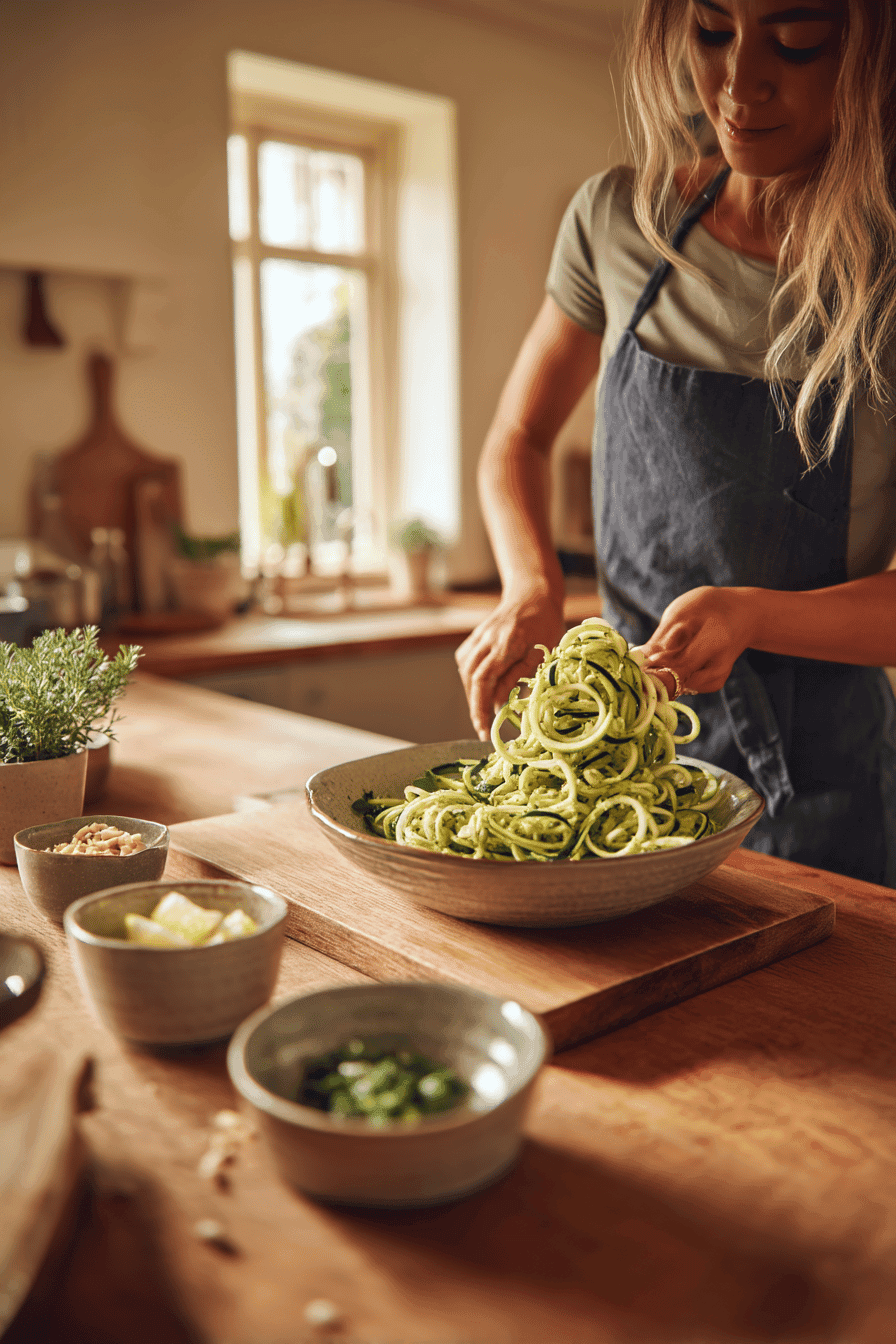
How to Prepare the Perfect Zucchini Pesto Pasta: Step-by-Step Guide
Creating zucchini pesto pasta is straightforward when following these clear steps, ensuring a fresh and delicious meal every time.
Step 1: Prepare the Zucchini Noodles
Wash 3 medium zucchinis thoroughly. Use a spiralizer or julienne peeler to convert the zucchinis into noodles, which serve as a gluten-free, low-calorie pasta alternative.
Step 2: Make the Basil Pesto
In a food processor, blend these ingredients until smooth:
- Fresh basil leaves (about 3 cups packed)
- 2 garlic cloves
- 1/4 cup nuts (pine nuts or walnuts)
- 1/2 cup extra-virgin olive oil
- Juice and zest of 1 lemon
- Salt and freshly ground black pepper to taste
- 3 tablespoons grated Parmesan cheese (or substitute with nutritional yeast for vegan versions)
For detailed pesto preparation tips, visit How to Make Basil Pesto Sauce.
Step 3: Toss the Zucchini Noodles with Pesto
Place the zucchini noodles in a large bowl. Gently toss them with the freshly made pesto until evenly coated, taking care not to bruise the noodles so they retain a slight crunch.
Step 4: Optional Heating
Briefly sauté the coated zucchini noodles in a skillet over medium heat for 2 to 3 minutes if you prefer a softer texture without turning them mushy.
Step 5: Season and Customize
Taste and adjust seasoning by adding extra salt, pepper, or lemon juice as needed.
Step 6: Add Protein or Texture (Optional)
For a heartier meal, fold in cooked chickpeas, grilled vegetables, or dairy-free cheese alternatives like vegan ricotta.
Step 7: Serve Immediately
Enjoy your zucchini pesto pasta warm for the best texture and flavor, or serve chilled for a refreshing cold pasta salad.
| Step | Action | Time |
|---|---|---|
| 1 | Prepare zucchini noodles | 5 minutes |
| 2 | Make pesto | 5 minutes |
| 3 | Toss noodles with pesto | 2 minutes |
| 4 | Optional sauté | 2–3 minutes |
| 5 | Season to taste | 1 minute |
| 6 | Add protein (optional) | 1 minute |
| 7 | Serve | Immediately |
This clear process helps create a bright and delicious zucchini pesto pasta, perfect for any skill level in the kitchen.
Advanced Tips and Variations
Try these ideas to personalize and vary your zucchini pesto pasta while keeping it fresh and exciting.
Nuts and Herbs
- Grind nuts before adding them to pesto for enhanced flavor and smoother texture.
- Add herbs like parsley, mint, or arugula alongside basil for subtle complexity.
Creamier Variations
- Add a splash of plant-based milk or creamy avocado to the pesto for a luxurious texture.
- Try different nuts such as cashews or almonds to alter taste and nutrient profile.
Roasted Garlic and Spice
- Roast garlic before blending into pesto to bring out sweetness and mellow flavors.
- Include red pepper flakes or fresh chili for a spicy kick.
Protein and Vegetable Substitutes
- Boost protein with cooked quinoa or toasted chickpeas added just before serving.
- Swap zucchini noodles with spiralized carrots or sweet potatoes for colorful alternatives.
Storage Suggestions
- Prepare pesto ahead and store in airtight containers to retain freshness.
These variations encourage experimentation while preserving the wholesome nature and delightful taste of zucchini pesto pasta.
How to Store Zucchini Pesto Pasta: Best Practices
Proper storage keeps your zucchini pesto pasta fresh, flavorful, and texturally pleasing for later enjoyment.
Refrigeration
Store the zucchini pesto pasta in an airtight container for up to 2 days. This maintains freshness while preventing the noodles from becoming soggy.
Pesto Freezing
- Freeze pesto separately in ice cube trays for up to 3 months. Thaw before use to keep optimal flavor.
- Avoid freezing zucchini noodles directly as they release water and become mushy upon thawing.
Reheating Tips
Rewarm refrigerated zucchini pesto pasta gently in a skillet over low heat to protect the noodles’ texture. Alternatively, serve cold as a refreshing meal option.
Handling Excess Moisture
If the zucchini noodles appear watery after storage, drain excess liquid before serving to enhance consistency.
| Storage Method | Duration | Notes |
|---|---|---|
| Refrigerate (combined) | Up to 2 days | Best for immediate use; noodles can soften |
| Freeze Pesto Alone | Up to 3 months | Thaw before use; preserves flavor |
| Freeze Zucchini Noodles | Not recommended | Leads to mushy texture after thawing |
Nutritional Value of Zucchini Pesto Pasta
This dish combines fresh vegetables and healthy fats to nourish effectively while being calorie-conscious.
Caloric Content and Macronutrients
| Nutrient | Approximate Amount Per Serving | Benefits |
|---|---|---|
| Calories | 200-250 kcal | Supports weight management with healthy fat sources |
| Protein | 5-8 grams | Moderate protein from nuts and optional cheese |
| Carbohydrates | Low to moderate | Primarily from zucchini and pasta; suitable for low-carb diets |
| Fiber | Good amount | Promotes digestion and gut health |
| Vitamins A & C | High levels | Boosts immune function and skin health |
| Healthy Fats | Monounsaturated fats | Supports cardiovascular health via olive oil |
| Calcium | Varies | From Parmesan or vegan cheese options |
| Iron & Magnesium | Small amounts | From nuts and fresh herbs |
Detailed nutritional information of pasta complements the zucchini and pesto nutrients, making this dish a wholesome and satisfying meal option.
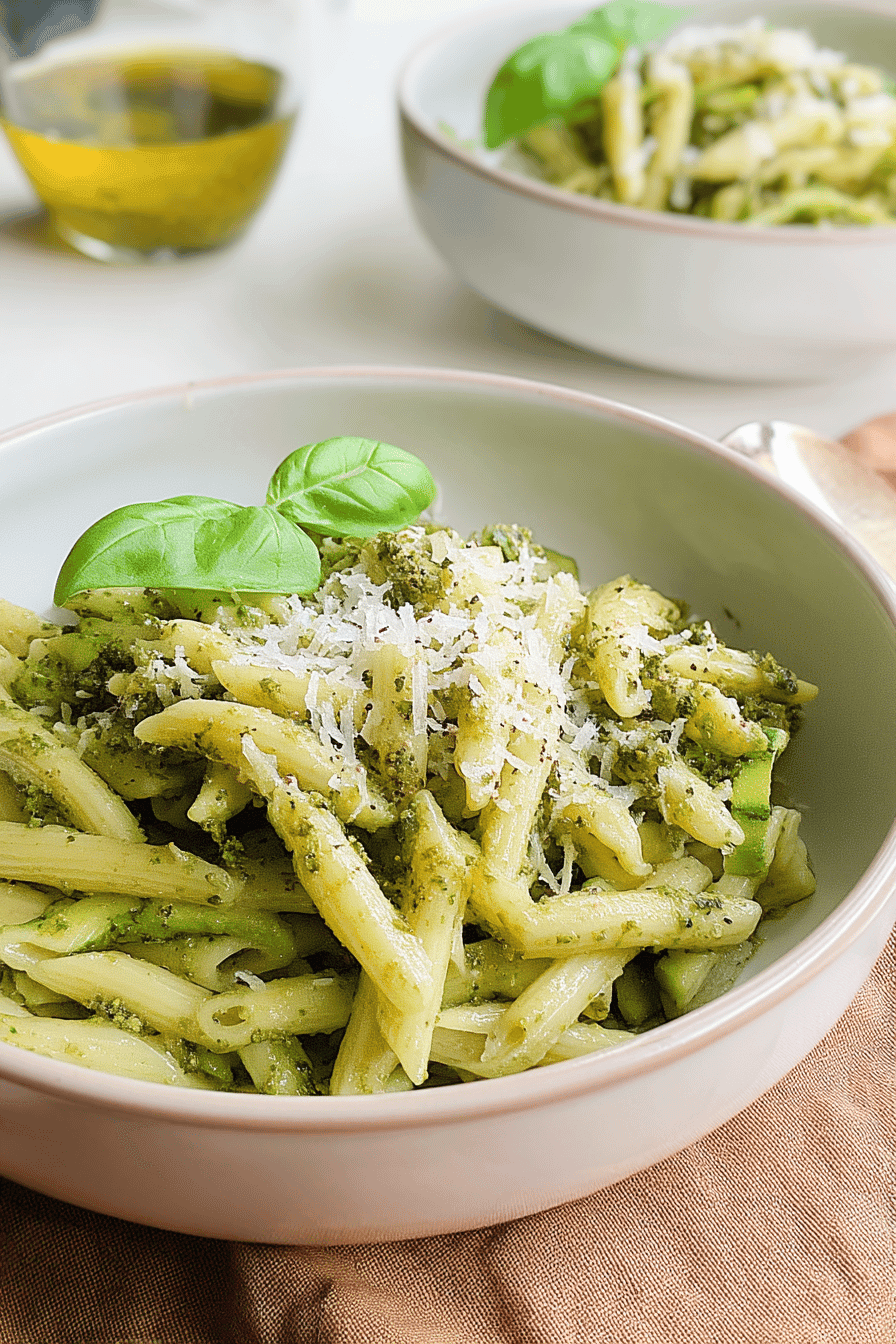
FAQs: Frequently Asked Questions About Zucchini Pesto Pasta
What ingredients do I need to make zucchini pesto pasta at home?
You will need 8 ounces dry pasta (penne, casarecce, or linguine), 3 medium zucchinis, 2 tablespoons minced garlic, 2 to 5 tablespoons extra-virgin olive oil, 1 cup basil pesto (store-bought or homemade), salt and black pepper, 1/2 cup grated Parmesan cheese (optional), and optional additions like butter, nuts, lemon zest, and fresh basil. The zucchini can be sliced or grated to your texture preference.
How can I make zucchini pesto pasta lower in carbs?
To lower carbs, increase the zucchini amount while reducing the pasta quantity, or use plant-based pasta alternatives such as those made from konjac or chickpea flour. Using spiralized zucchini alone also provides a very low-carb option. These modifications substantially reduce carbohydrate content per serving.
What pasta shape works best with pesto sauce for zucchini pesto pasta?
Pasta shapes with grooves or edges like penne, casarecce, rotini, and linguine are ideal as they hold the pesto sauce better, allowing full flavor coating and better texture with the zucchini and pesto combination.
Can I use store-bought pesto when making zucchini pesto pasta, and how does it affect flavor?
Yes, store-bought pesto can be used conveniently. While it may have a slightly different flavor profile compared to fresh homemade pesto, enhancing it with a squeeze of fresh lemon juice or a sprinkle of fresh herbs can brighten and elevate the taste effectively.
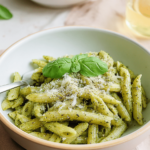
Quick and Creamy Zucchini Pesto Pasta Recipe in 30 Minutes
- Total Time: 30-35 minutes
- Yield: 4 servings 1x
- Diet: Vegetarian
Description
🥒 This Quick and Creamy Zucchini Pesto Pasta offers a vibrant, nutritious dinner option that’s ready in just 30 minutes.
🌿 Enjoy a flavorful blend of tender zucchini, fresh basil pesto, and pasta that’s perfect for a wholesome weeknight meal.
Ingredients
8 ounces dry pasta (penne, casarecce, linguine, or similar shape)
2 teaspoons salt for pasta cooking water
3 medium zucchinis (about 1 1/2 pounds), trimmed and sliced or coarsely grated
2 tablespoons minced garlic or 2 thinly sliced garlic cloves
2 to 5 tablespoons extra-virgin olive oil, divided
Salt and freshly ground black pepper, to taste
1 cup basil pesto (store-bought or homemade)
1/2 to 1 cup reserved pasta cooking water
1/2 cup coarsely grated Parmesan cheese (optional)
2 tablespoons unsalted butter (optional)
1/4 cup toasted walnuts or pistachios (optional)
1 lemon, zest and juice (optional)
Fresh basil for garnish (optional)
1/4 cup burrata or ricotta for garnish (optional)
Instructions
1. Bring a large pot of salted water to a boil (about 2 teaspoons salt). Add pasta and cook until al dente according to package instructions (10-17 minutes). Reserve 1/2 to 1 cup pasta cooking water before draining.
2. While pasta cooks, prepare zucchinis by slicing into half-moons or coins for tender-crisp texture, or coarsely grate for a caramelized flavor.
3. Heat 2 to 3 tablespoons olive oil (and optional 2 tablespoons butter) in a large skillet over medium heat. Add garlic and cook until fragrant (~1 minute).
4. Add zucchini, season with salt and pepper, and sauté for 5 to 10 minutes until tender or caramelized. For richer flavor, cook grated zucchini longer.
5. Toast nuts in a separate skillet for 3 to 5 minutes if using. Set aside.
6. Stir basil pesto into zucchini mixture. Gradually add reserved pasta water to create a smooth sauce.
7. Drain pasta and add directly to skillet with zucchini-pesto sauce. Toss over medium heat for a few minutes to combine flavors.
8. Serve hot, topped with Parmesan or dollops of burrata/ricotta, toasted nuts, and fresh basil leaves.
Notes
🟢 Choose pasta shapes with grooves or edges (like penne or casarecce) for better pesto adherence.
💧 Saving starchy pasta water allows creation of a creamy sauce that coats pasta evenly.
🌱 To reduce carbs, increase zucchini quantity and reduce pasta or substitute with plant-based noodles.
- Prep Time: 10 minutes
- Cook Time: 20-25 minutes
- Category: Dinner
- Method: Sautéing
- Cuisine: Italian
Nutrition
- Serving Size: 1 serving
- Calories: 420 kcal
- Sugar: 4 g
- Sodium: 450 mg
- Fat: 18 g
- Saturated Fat: 4 g
- Unsaturated Fat: 13 g
- Trans Fat: 0 g
- Carbohydrates: 52 g
- Fiber: 6 g
- Protein: 12 g
- Cholesterol: 10 mg
Keywords: Zucchini, Pesto, Pasta, Quick

